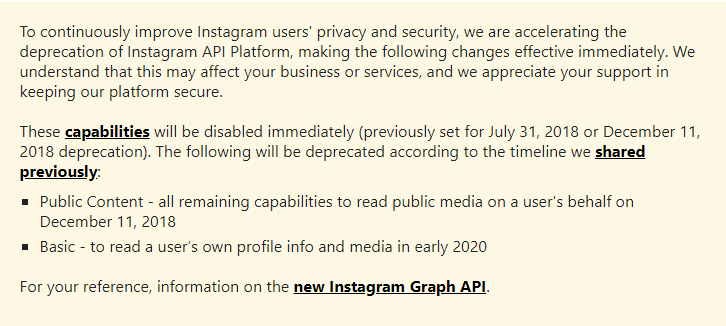The year 2018 is turning out to be significant for Instagram. The social media platform reached over a billion users in June. We’ve seen the launch of exciting features like IGTV, a platform similar to “Instagram meets YouTube.” However, for businesses that depend on Instagram, the biggest news was the sudden shift from the Instagram API to the Instagram Graph API. In this article, we’ll explore these new changes and how they could impact your social media strategy moving forward.
Farewell, Old Instagram API
APIs (application programming interfaces) are a vital component of a modern social media marketing strategy. Though the Instagram API was originally slated for deprecation on July 31, developers were faced with a rude awakening when many apps stopped working properly or outright broke:
Imagine waking up to this.
We all knew it was coming, just not this fast. The passing of the old Instagram API is disrupting the Instagram marketing landscape:
- Wave goodbye to Instagram bots. Brands will no longer have bots (at least those using the web API) following and unfollowing accounts. The new API doesn’t allow for automating tasks like checking follower lists, following/unfollowing users, and commenting on others’ posts. Follower counts are now more accurate.
- Your likes are now private. Other companies won’t be able to tell what posts you’ve liked or not. Shopping apps that kept track of items you wish to purchase via your Instagram “likes” no longer work.
- Analytics apps were nerfed. Instagram’s hourly API request limit shrank from 5,000 to 200 calls per user. Because the world is now more conscious of data privacy and security than ever before, third-party apps can only grab statistics for users with a business profile, and significantly stricter rate limits were placed on user-tracking API calls.
- Influencers must change their game. On the one hand, the data caps and anti-bot changes definitely impacted influencers. On the other hand, Instagram has added plenty of new features and tools to help content creators do their thing. We’ll cover those and more in the next section.
Meet the New APIs
The Instagram Graph API was built on Facebook’s Graph API and supports all the basic CRUD operations expected of a REST API. It uses social graphs to represent information on Instagram in the same manner:
- Nodes, which are objects such as users, photos, and comments.
- Edges, which are connections between objects.
- Fields, which are properties on an object that can be returned by the API on request.
Learn more about nodes, edges, and graph databases in our Guide to Graph Databases article.
Instagram’s parent company, Facebook, seems to really be consolidating its developer workflows here; endpoints can be accessed via the graph.facebook.com host just like the Graph API. Let’s take a closer look at some of the new APIs:
- Mentions API is an exciting new feature for marketers and influencers that gives users a way to mention your business in photos, comments, and captions. Users can tag business account aliases in photos or by @mentioning them in comments and captions.
- Insights API gives you endpoints for pulling metrics and metadata from your own Instagram business account. This API lets you track metrics such as your reach, impressions, and profile views.
- Business Discovery API gives you endpoints for pulling metrics and metadata from other Instagram business accounts. Track the number of followers, comments, likes, and more.
- Content Publishing API lets you automate the posting of photos and the tagging of users and locations.
- Comment Moderation API gives you control over comments on your media. It enables you to reply, delete, hide/unhide, and disable/enable comments on a media object. You can even do batch replies to multiple comments.
New Features
Like any other good social media platform, Instagram is constantly coming up with new features to keep things fresh. Some highlights from 2018:
- IGTV (Instagram TV) is Instagram’s new video media platform geared toward long-form, vertical video content. It can be accessed as a stand-alone app or viewed within Instagram, and it starts streaming content as soon as the user opens it. With up to an hour of video, IGTV is sure to be boon for both content creators and brands looking for a new platform to build recognition and engagement.
- Instagram topic channels offer a new way to connect with your target audience. Topic channels appear at the top of the Explore section in the Instagram app, highlighting categories such as Art, Fitness, and Beauty based on user activity.
- Video chat in direct messaging. Similar to FaceTime or Google Hangout, this feature supports video chats of up to four people.
- Stories now have music, @mention, and shoppable tags. Instagram’s most engaged users love stories. You can now craft stories with music to set the tone, have an influencer tag your brand with @mention, and tag actual products to close the sale.
Final Thoughts
We haven’t even finished summer, and 2018 has already proven to be one of Instagram’s biggest years yet. While the deprecation of the old Instagram API may have put a damper on the most data-driven marketing campaigns, the new APIs and features present more than enough opportunities for savvy social media marketers to adapt and continue to grow their campaigns with the platform. If you want to take full advantage of Instagram’s new API and features, you’re going to want to work with a web or mobile developer who’s familiar with the capabilities of the new Instagram Graph API.

